The seven-seat Hyundai Santa Fe family SUV is getting on in age, but can a new frugal hybrid powertrain attract more buyers, compete with Toyota, and replace diesel as its marketing campaign suggests?
According to Hyundai Australia’s ‘Go the Distance’ advertisement campaign, the Santa Fe Hybrid can substitute venerable diesels and subtly hints it as a stop-gap alternative to full battery-electric vehicles.
The brand emphasises long driving range, towing capabilities, and strong torque. But, can the Santa Fe Hybrid truly replace a diesel in reality?
I tested the mid-spec Elite variant, which is the cheapest way to get into an electrified Santa Fe SUV, priced below $70,000 drive-away.
EDITOR’S NOTE: The test vehicle was provided by Hyundai Australia for a seven-day independent evaluation. No copy approval was given before publication and we have no commercial arrangements with the company.
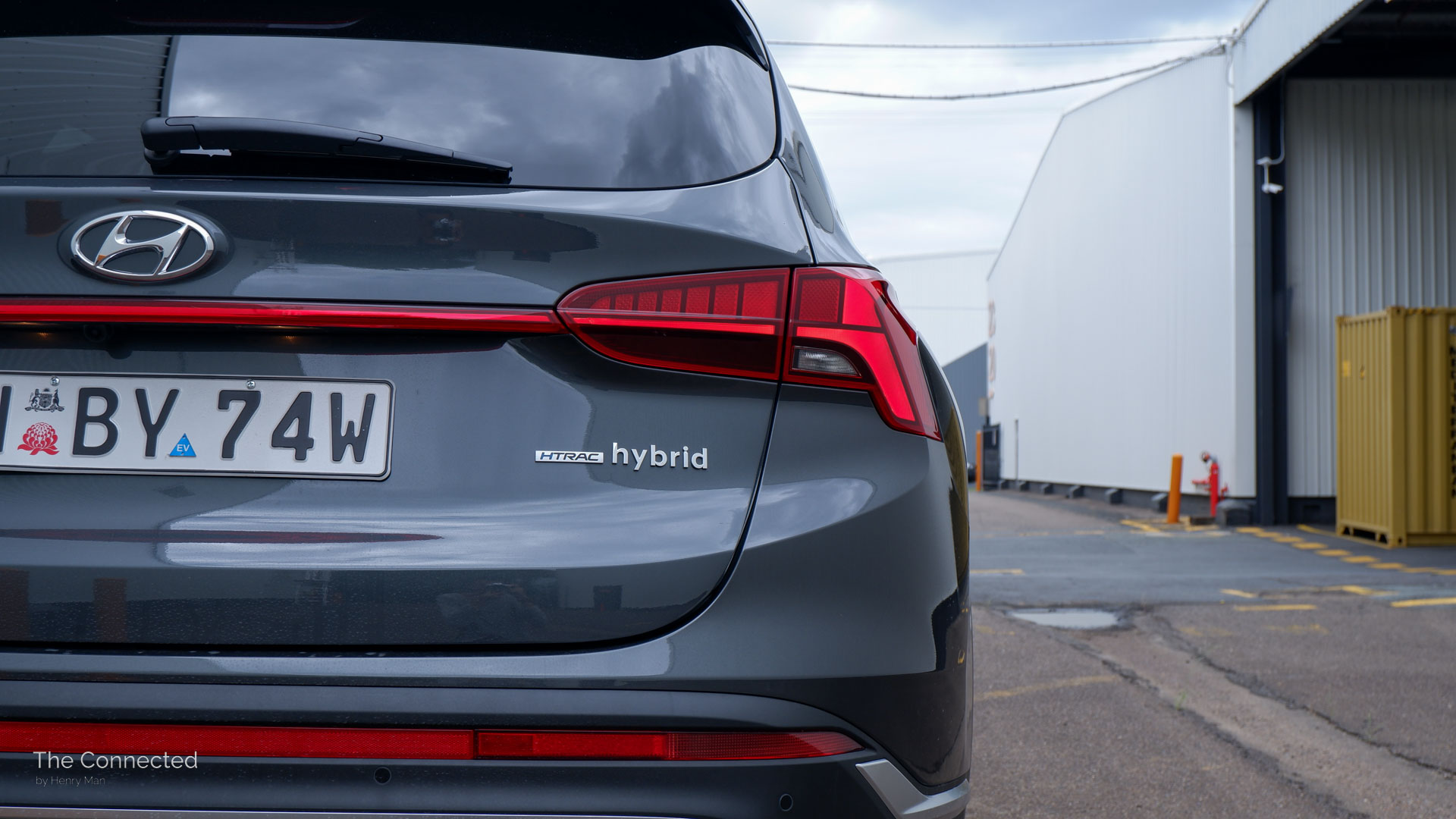

Pros
+ Frequent electric-only moments
+ Long diesel-like driving range
+ Practical interior
+ Confusingly good physical buttons
Cons
– Could be more fuel efficient compared to claim
– Noticeable powertrain delay
– Sizable hybrid price premium
– Third-row seats for occasional use only
– 360-degree camera, reverse AEB reserved for top-spec
Car as tested:
| Model | 2023 Hyundai Santa Fe Hybrid |
| Variant | Elite |
| Starting price | $63,000 before on-road costs |
| Exterior colour | Magnetic Force ($695) |
| Interior colour | Black leather (no cost) |
| Country made | South Korea |

Design.
Although the current generation Santa Fe is getting on in age, the design still looks quite sharp and rugged, without being overly buff.
The split T-shaped double-line LED daytime running lights that was introduced with the 2020 facelift, sub-par sized (for a large SUV) black hexagonal grille, and contrasting satin silver trim are interesting touches that help set it apart from other SUVs.
Meanwhile, the rear is more mature with a full-width light reflector discreetly hiding the LED turn indicators and fog light, slimmer LED-incandescent combination tail-lights which are connected by a reflector strip, and more prominent satin cladding at the lower bumper.


This mid-spec Elite model maintains some plastic cladding around the wheel arches and lower sections (the flagship Highlander removes it for body-coloured paint), but it’s quite discreet in this quite sleek optional Magnetic Force paint colour.
All Santa Fe Hybrid models exclusively feature smaller 19-inch alloy wheels with a unique aerodynamic star design, plus requisite ‘hybrid’ badging at the rear.
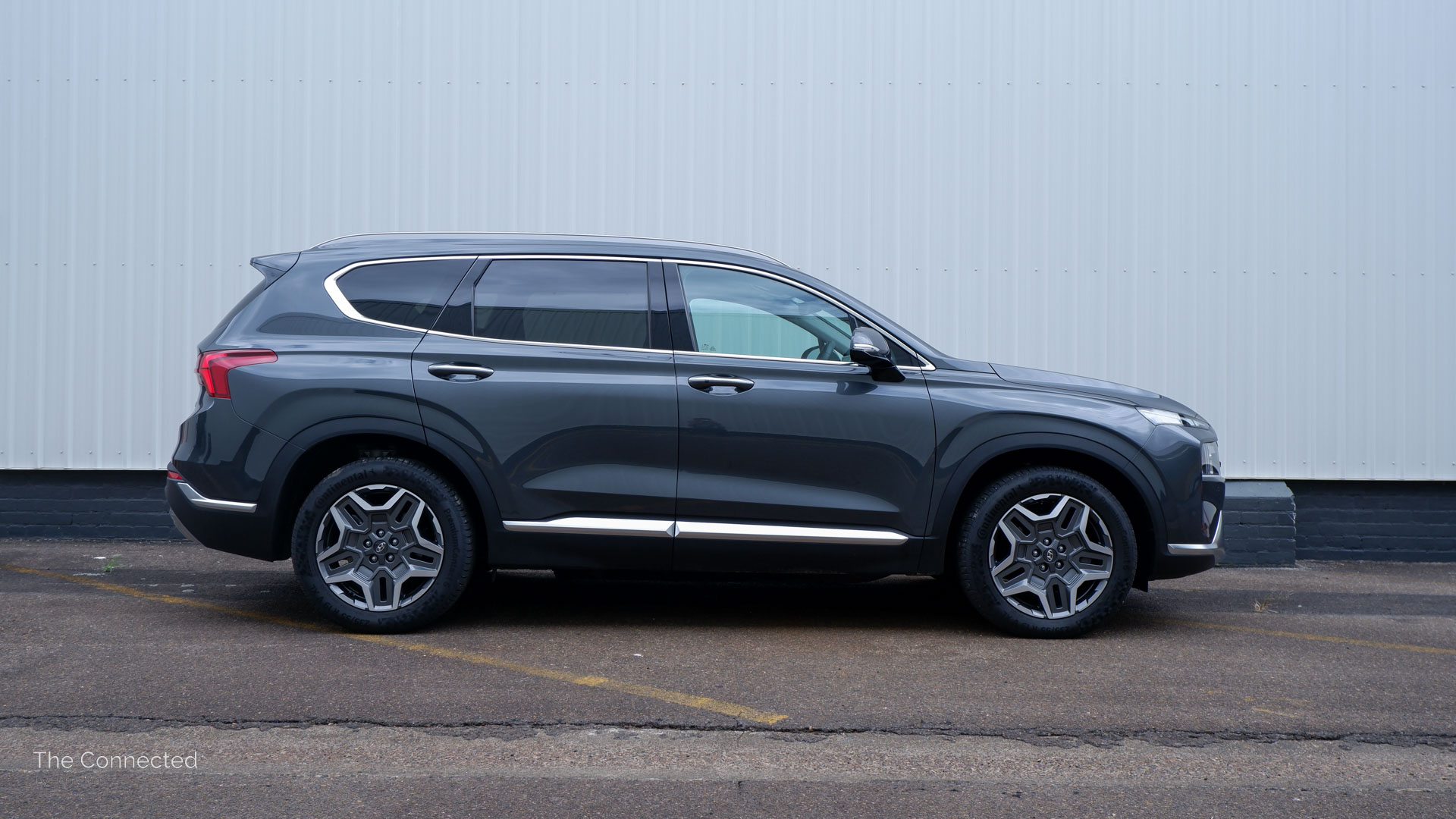
Note to self.
The fourth-generation large family SUV launched in 2018 with a petrol or optional diesel engine, before quickly receiving a facelift in 2020. A new-gen model is rumoured to be on the horizon.
The Santa Fe is named after a city in New Mexico as Hyundai’s first-ever SUV that launched in 2001.


The Hyundai Santa Fe’s interior still feels quite modern with good quality plastics and padded leather throughout.
The matte silver trim continues on the inside, which is complemented by a faux gloss carbon fibre material, and double-line stitching.
A unique design detail is the carved out dashboard which neatly flows into the tablet-style protruding touchscreen and doors, while the centre console is home to a plethora of physical buttons, switches and knobs.
Similarly, the speaker grille across all four doors has a three-dimensional rocky diamond effect that’s reminiscent of the Kia Seltos small SUV.
The little design touches help lift up the monochrome black interior, though I’d wager the $295 optional Cognac Brown interior (or even better the Camel Beige exclusive to the Highlander) would make the Santa Fe feel more upmarket.
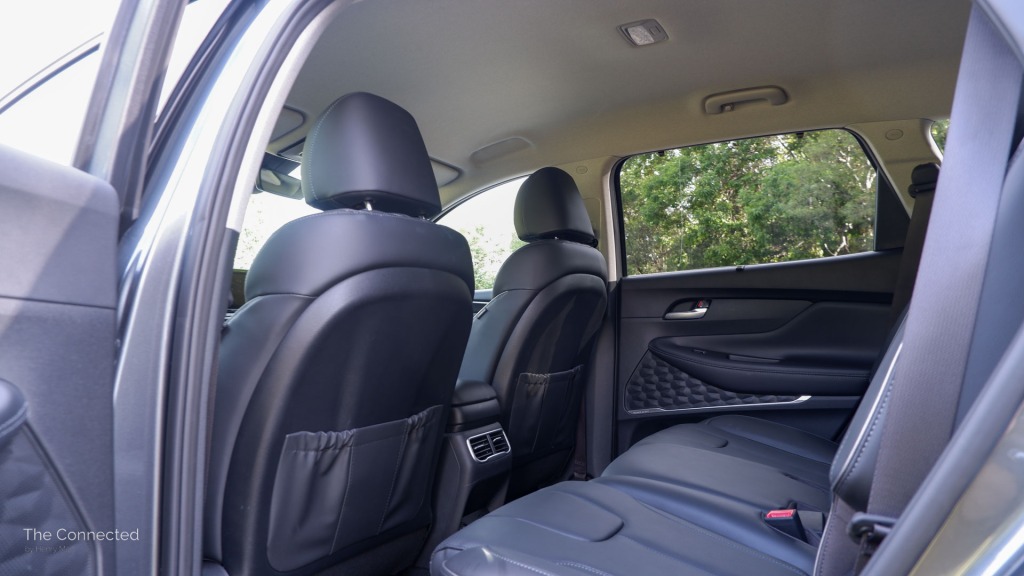
Practicality.
2023 Hyundai Santa Fe Hybrid dimensions:
| Length | 4785mm |
| Width | 1900mm |
| Height | 1685mm (1710mm with roof rails) |
| Wheelbase | 2765mm |
| Ground clearance | 176mm |
| Cargo capacity (third-row seats folded) | 571-litres |
| Cargo capacity (second- and third-row seats folded) | 782-litres |
| Rear seat split fold | 60:40 |
| Child seat anchors | 2x ISOFIX second-row outboard seats + 3x top tethers |
The Santa Fe Hybrid’s boot volume is identical to the regular petrol-only and diesel versions, and still includes a full-size spare tyre underneath the vehicle.
While Hyundai doesn’t detail the capacity when all three-row seats are in place, I could only manage to put a backpack and smaller items, plus there’s no dedicated place to store the cargo blind (which you need to remove to use the third-row) nor bag hooks (only clips).
Folding the third-row via the easy pull latches liberates the boot significantly to 571-litres and there’s an almost flat loading lip with the SUV’s bumper. However, wider items will need to contend with the protruding wheel arch cup holders and dangling seatbelts from the side.

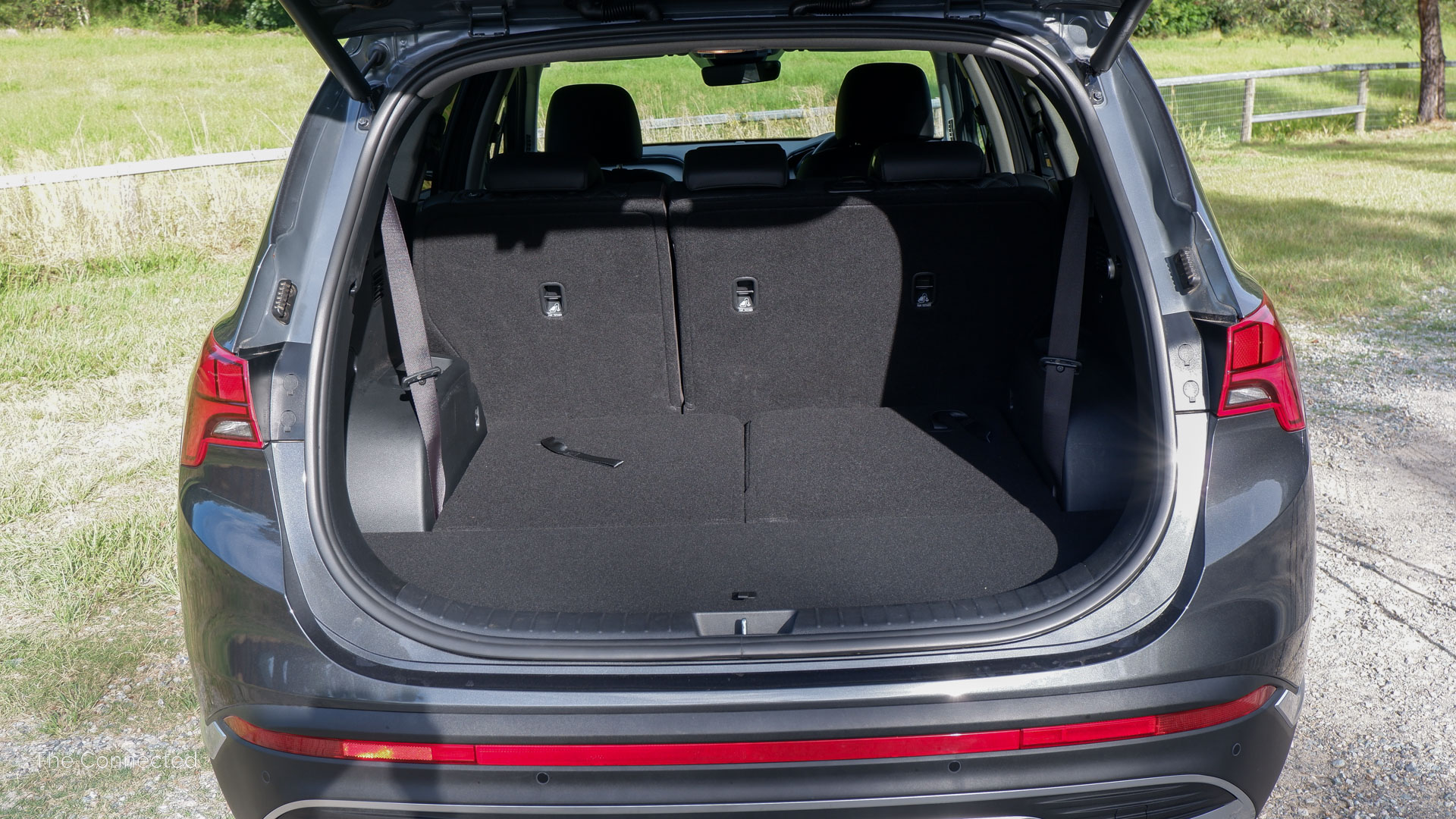
There’s also handy release toggles to quickly fold the second-row in a 60:40 split.
Additionally, child seats must only be fitted at the second-row as the two third-row seats lack ISOFIX and top tether child seat anchor points.
This means the third-row is suited for occasional use only and for older children or young teenagers.
Adults can fit for short trips when needed, but legroom is almost non-existent when the second-row is slid in its furthest position and heads will touch the boot’s ceiling when leaned back.
The third-row seat base is also quite flat and the cup holders can be intrusive (there’s no padded armrest), but it does feature rear side air vents with fan speed controls and a USB-A charging port.




Thankfully, there there are release buttons on the side and top of the curb-side seat to quickly slide and fold it forward for ingress/egress into the third-row. As is the case for all seven-seater SUVs, it won’t be elegant, though, and the bench defaults to a more forward and straight backrest position when pushed back.
At the second-row, it’s more accommodating with plenty of legroom and headroom, plus a flat floor, built-in sunshades, tinted windows, a fold-down centre armrest with cup holders, air vents, and USB-A ports.
The 60:40 seat bench can slide forwards or backwards, and the seatbacks can recline using manual levers on the side. The rear doors cover the sills (to prevent collecting dust) and have a wide opening.
However, it’s worth pointing out that this Elite variant’s incandescent interior lighting can be quite dim at night; only the top-spec Highlander gets LED illumination.

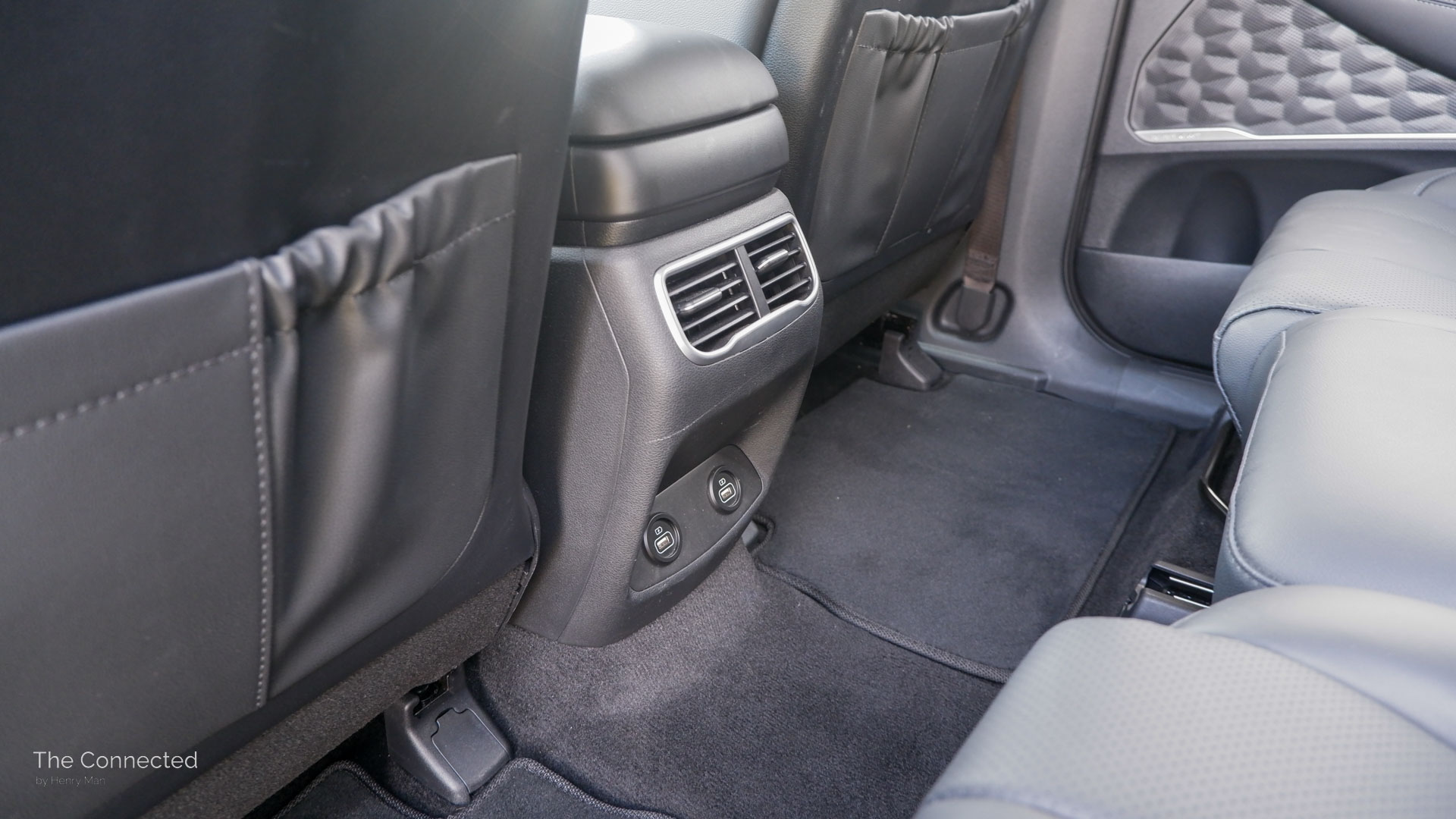


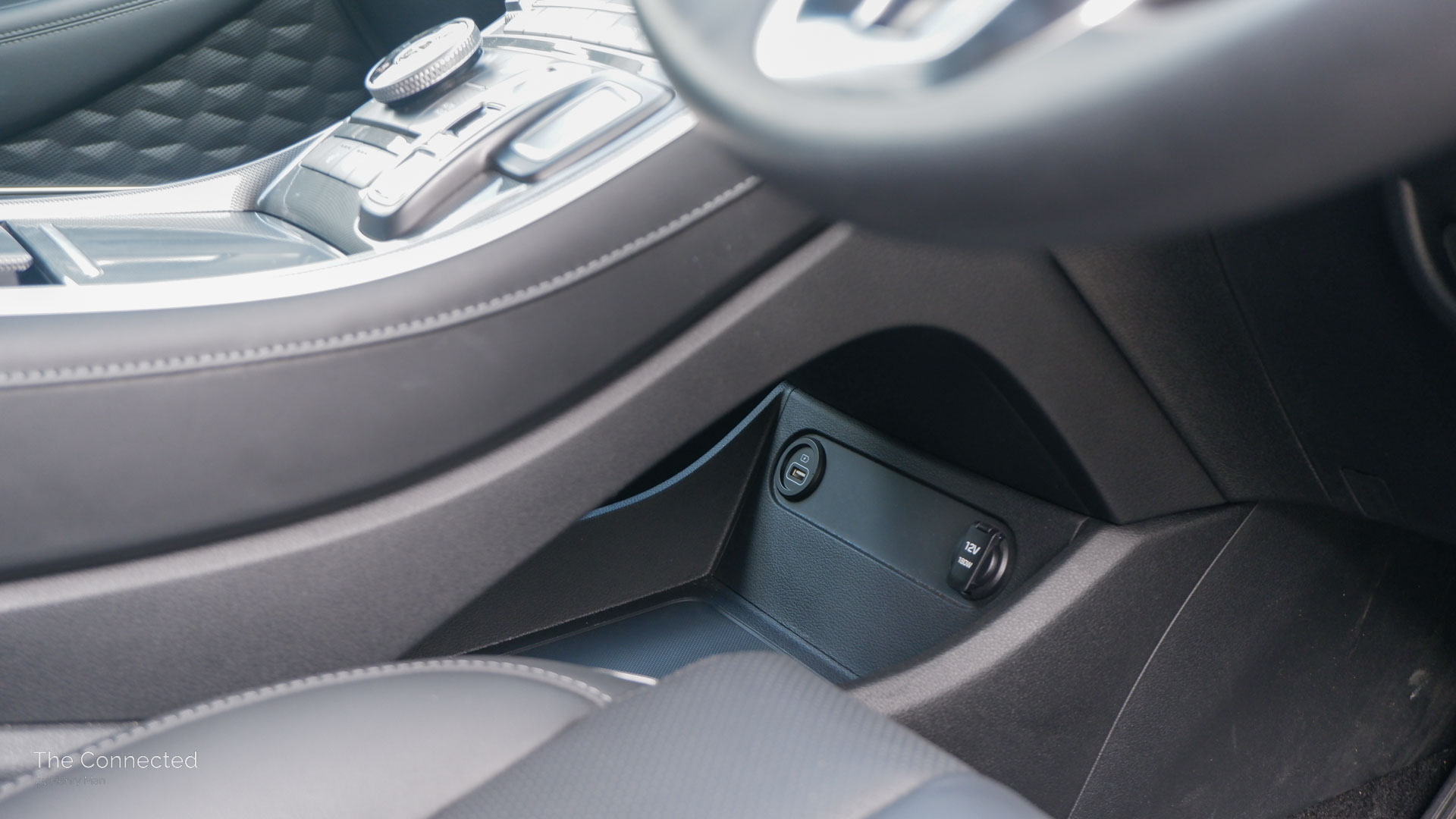

At the front, the two cup holders at the centre stack interestingly aren’t on the same level and the Qi wireless phone charging pad is vertical with a nifty slot mechanism to hold it in place.
Some thoughtful touches include the open tray ahead of the front passenger and a hidden storage area underneath the rising centre console bridge with a USB-A and 12-volt power sockets.
All seats are covered in a leatherette material, which feels good quality and was comfortable, so the Nappa leather on the range-topping Highlander doesn’t seem as necessary.
Both the driver and front passenger seat are heated and electrically adjustable (with two driver memory profiles) – though it’s a shame that this Elite still lacks ventilation and a heated steering wheel, as features for the Highlander only.

Technology.
2023 Hyundai Santa Fe Hybrid Elite tech features:
| 10.25-inch touchscreen with built-in navigation | 12.3-inch driver instrument display |
| Wired Apple CarPlay and wired Android Auto | Qi wireless charging pad |
| AM/FM/DAB radio | Keyless entry with push button start |
| 10-speaker Harman Kardon audio | Auto power folding mirrors with puddle lights and front door handle lights |
The Hyundai Santa Fe Hybrid features a 10.25-inch infotainment system running on the company’s own software, which performs well with a modern and fairly simple interface.
Notably, the hybrid app displays how the series-parallel system is operating in real-time (in addition to the instrument cluster) with a line graph showing the engine and electric motor use.
The Passenger Talk intercom feature is also quite clever by pumping the front microphones to the rear seats (so parents don’t have to yell). Though, unlike the bigger Hyundai Palisade, there’s no physical favourites shortcut button, so it needs to be activated by delving into the touchscreen app or side widget.

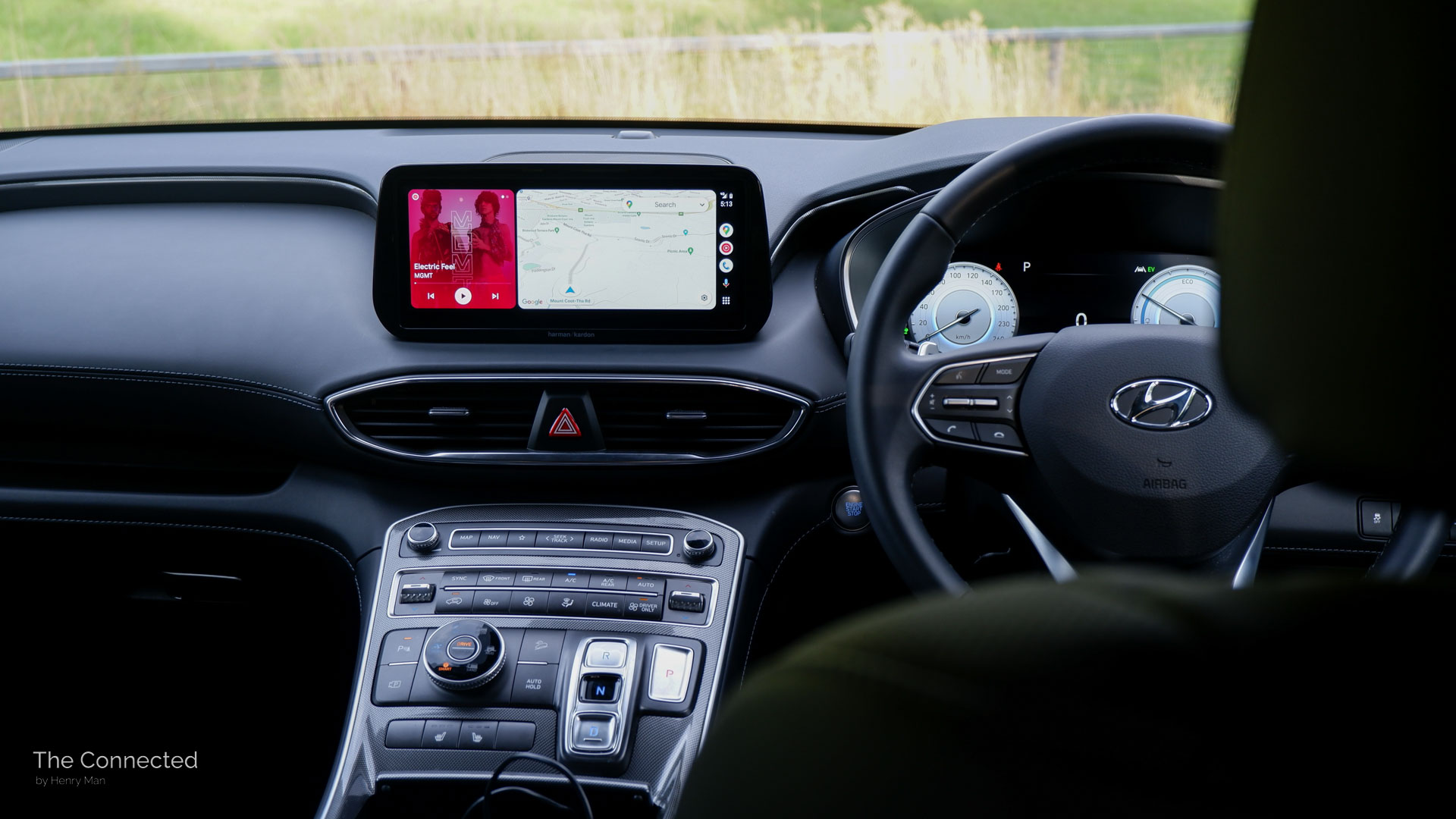

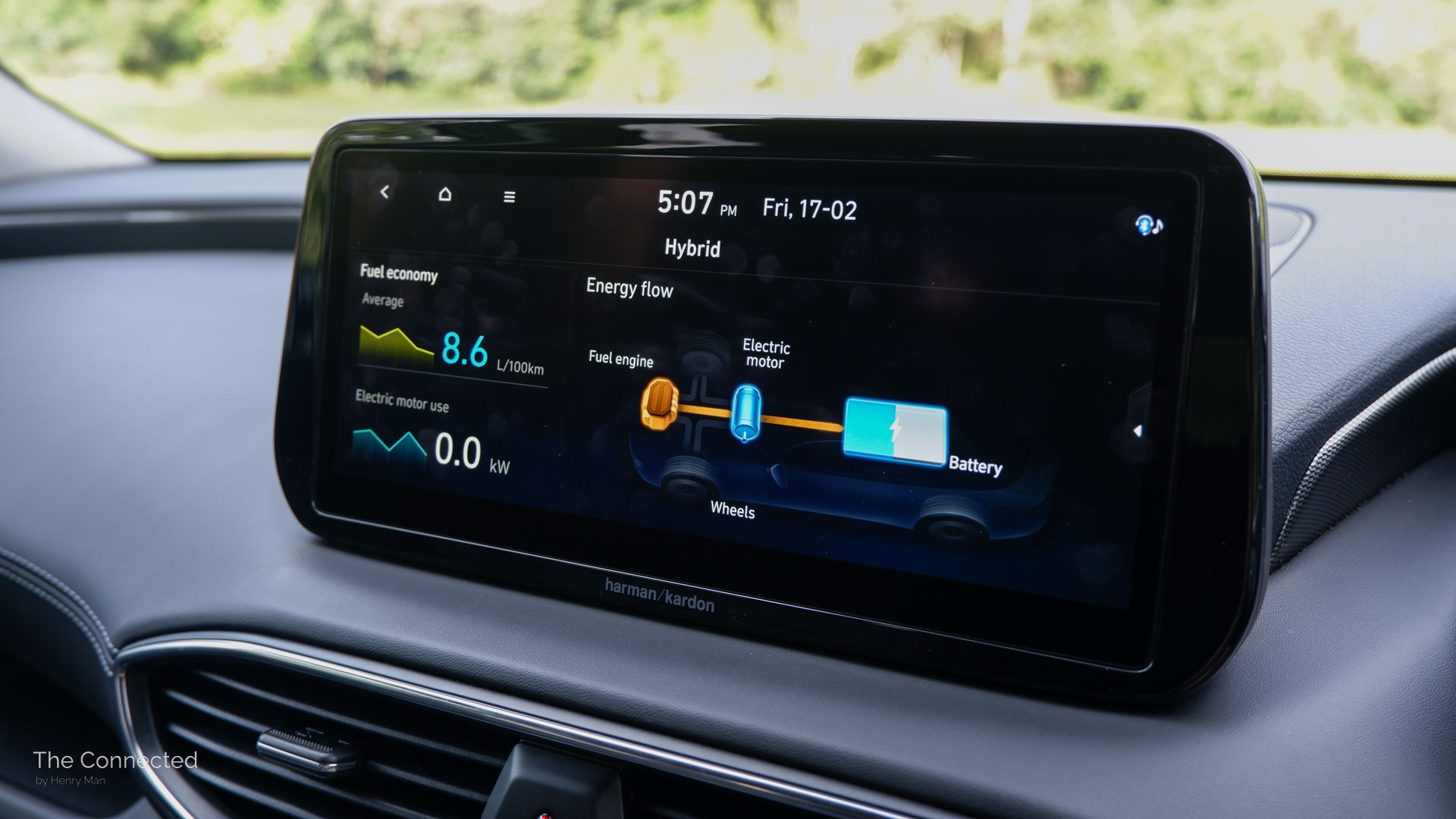
While the display isn’t as large compared to other large SUVs nowadays, it’s set forward in the dashboard so it doesn’t appear too small and is easy to reach.
Wired Apple CarPlay and wired Android Auto is via the single USB-A port at the front, with both systems stretching the full horizontal screen. The built-in system can also add a side panel to display widgets, such as a large digital clock and toggling Passenger Talk.
The centre console packs a plethora of tactile physical buttons and, while they’re separated in rows, it can be confusing at times to decipher the temperature air-con switch from the drive mode dial, gear selector and heated seat button, for example.
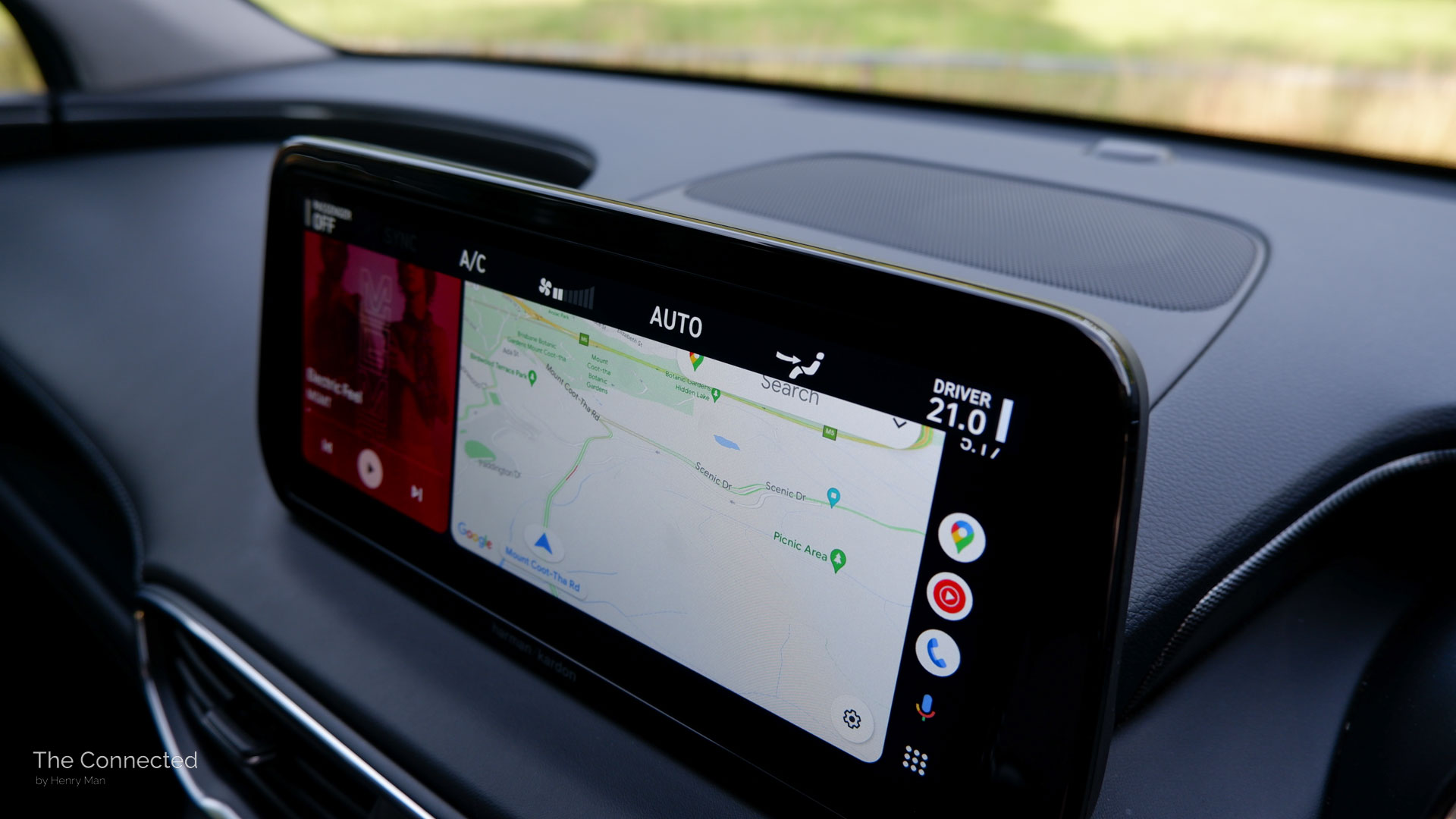

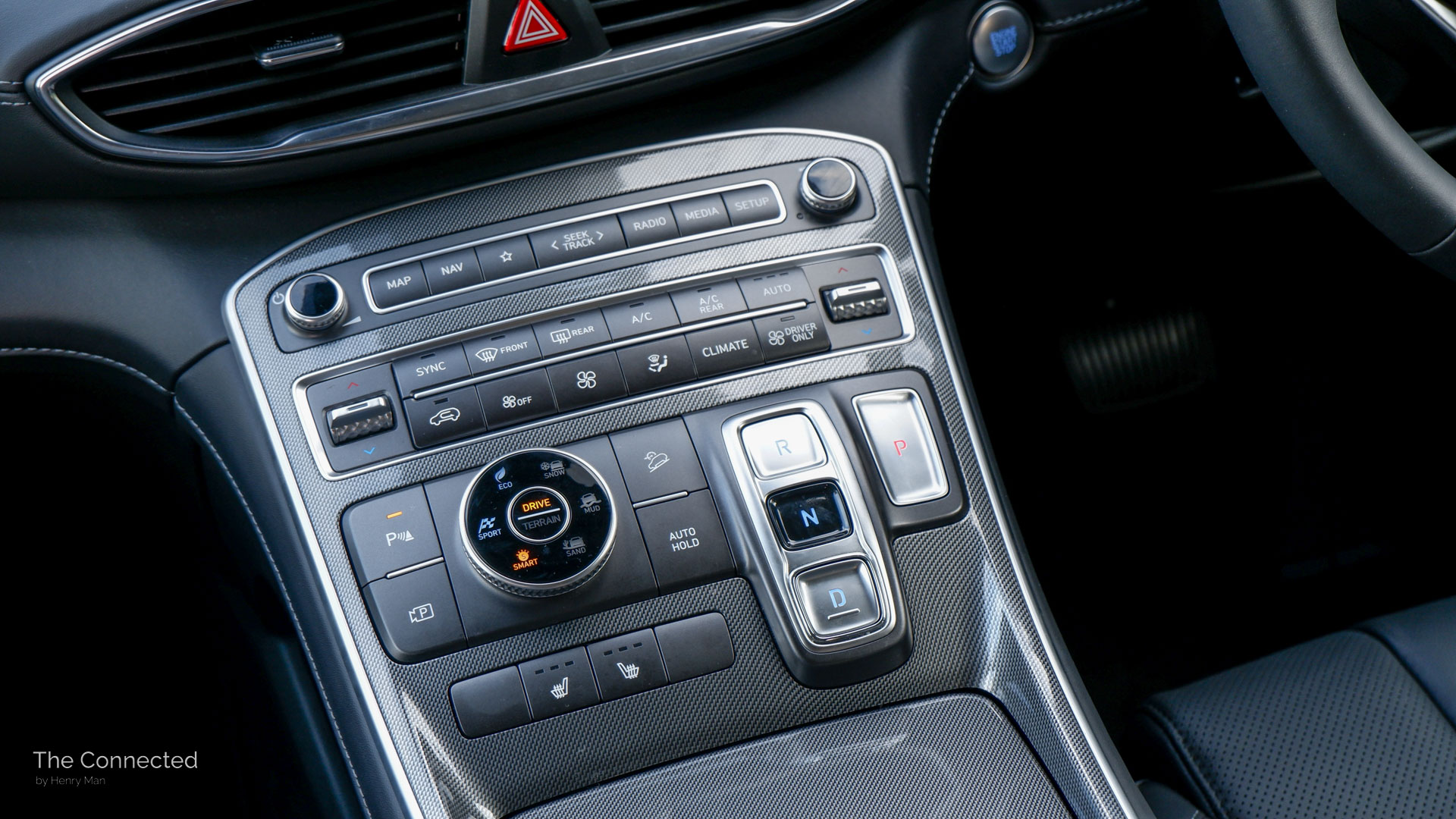

Annoyingly, the Santa Fe doesn’t feature a dedicated climate control LCD screen, so you’ll need to dive into a dedicated infotainment app or change a setting in order to trigger a pop-up on the touchscreen.
Alas, there are still physical buttons and switches, but not having a temperature and fan speed readout is a disappointing half-baked design – unlike the bigger Hyundai Palisade SUV.
The 12.3-inch driver instrument display is clear with smooth animations when switching drive modes. It isn’t as customisable and the lack of a head-up display in this Elite spec meant I mostly left it on the digital speedometer page.
Meanwhile, the 10-speaker Harman Kardon branded audio system was adequate, though it did sound more immersive thanks to the larger interior and speakers stretching into the third-row.
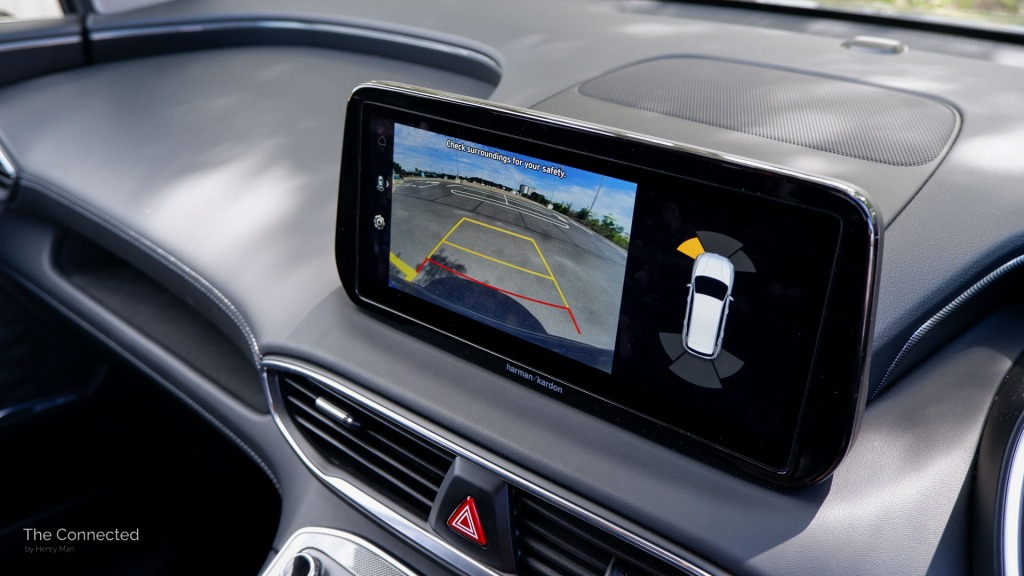
Safety.
2023 Hyundai Santa Fe Hybrid Elite safety features:
| Front auto emergency braking (AEB) with car/pedestrian/cyclist/junction detection | Adaptive cruise control |
| Blind-spot assist | Lane centring and keep assist |
| Rear cross-traffic assist | High beam headlight assist |
| Rear view camera | Rear occupant alert (radar-based) |
| Front and rear parking sensors | Safe exit assist |
The Hyundai Santa Fe Hybrid hasn’t been tested yet by ANCAP, but the regular petrol and diesel version obtained a five-star safety score under the 2018 criteria.
Hyundai Motor Group’s adaptive cruise control works well, though the Santa Fe seems to use an older system that can’t adjust the overspeed threshold and can go up to 5km/h above the set limit while going down an incline before applying the brakes.
I do applaud the ability to activate lane centring assist at any speed and without the need to enable adaptive cruise, which isn’t common in other car brands today.

About the airbags.
The curtain airbags only cover up to the rear windows, so third-row passengers aren’t protected at the head and body area.
Despite this, it still achieved the full ANCAP safety score in 2018.
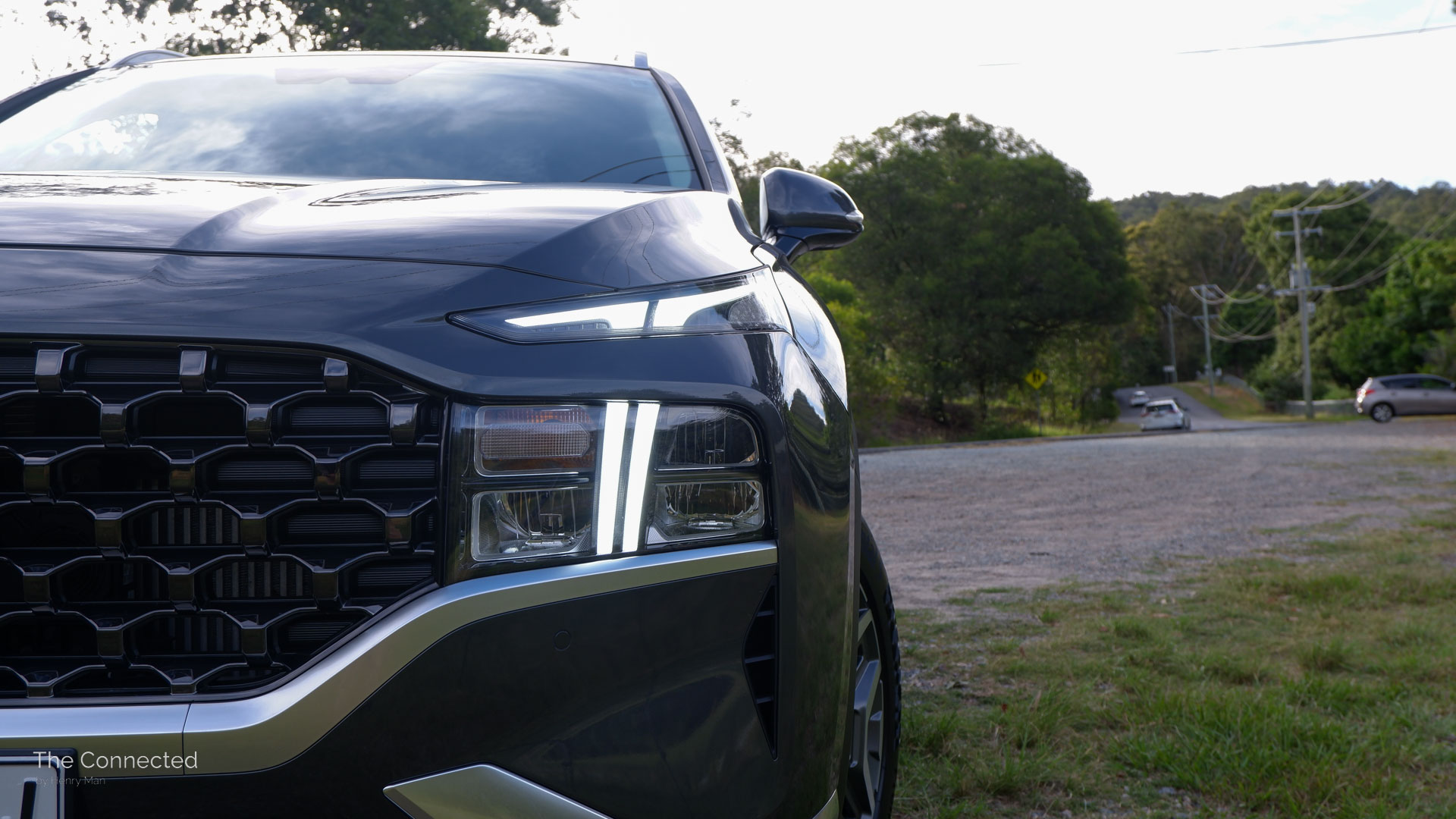
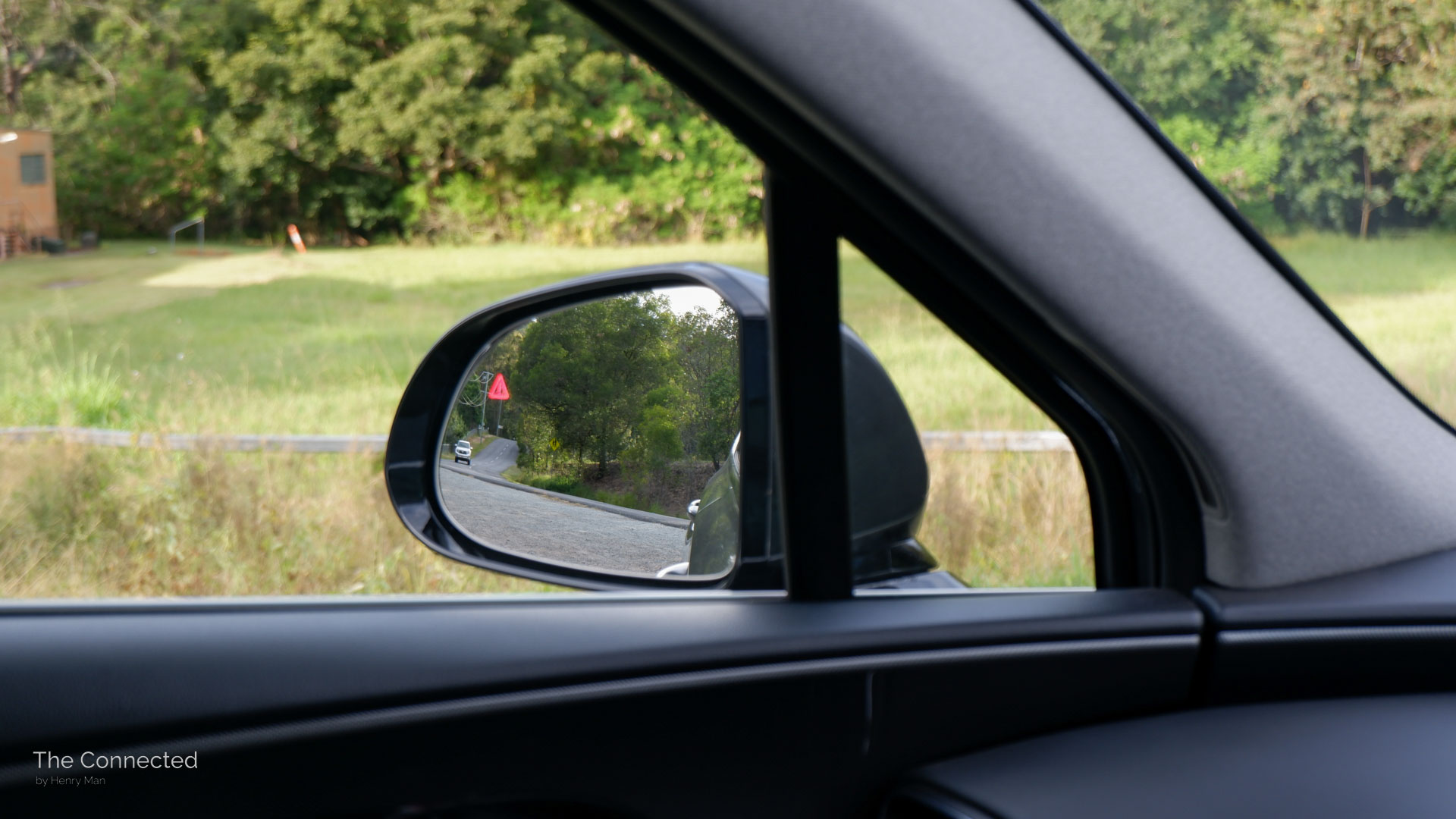
Critically, this mid-spec Elite still doesn’t have a 360-degree camera system, reverse AEB, blind-spot view camera, and lacks an auto tilt-down mirror function when reversing.
For a large family SUV, these safety systems should be standard at this price point and not reserved for the most expensive Highlander.
However, the large LED headlight units mean they perform well at night with good spread and reach, despite only the top-spec gaining improved projector-type LEDs.
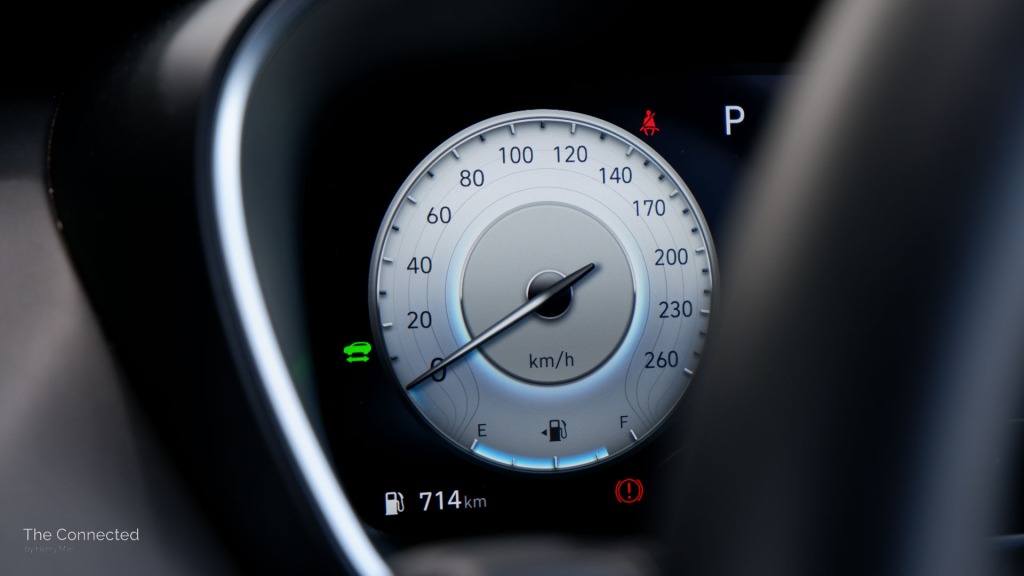
Fuel consumption.
2023 Hyundai Santa Fe Hybrid fuel and efficiency specs:
| Theoretical claimed driving range | 1117km |
| Claimed fuel efficiency (combined) | 6.0L/100km |
| Fuel tank | 67-litres |
| Minimum fuel quality requirement | 91RON |
| European emissions compliance | Euro 5 |
Here’s the key selling point of the Santa Fe Hybrid: fuel efficiency and diesel-like long range, but does it hold true? Well, yes with caveats.
In my week of driving a mix of urban and highway environments, the series-parallel hybrid family SUV only managed 7.5L/100km, resulting in 893km real-world range from a full tank.
The tested consumption is a far cry from Hyundai’s claim, but does answer that it can be a viable diesel substitute.
But, you’ll only achieve lower consumption and longer range if you regularly commute in urban conditions, where there are more opportunities for regenerative braking and ‘EV-only moments’.

Hyundai’s marketing.
Hyundai Australia’s Santa Fe Hybrid ‘Go the Distance’ marketing campaign launched in November 2022.
The video commercial features a family who don’t need to frequently stop at fuel stations, buy convenience store food, and can confidently tow a boat while overtaking a heavy-duty truck.


The small lithium-ion battery recharges quickly via regenerative braking, even though it relies on the blended brake pedal since the default recuperation intensity is very weak and there’s no setting to adjust it.
Despite the added electric components, the Santa Fe Hybrid features the same 67-litre fuel tank volume as regular petrol and diesel models, and can take in cheaper regular unleaded fuel.
However, the hybrid does demand a hefty $6500 price premium compared to the standard petrol or $3000 more than the diesel.
Based on the combined fuel claims and assuming an owner drives 15,000km per year with unleaded petrol costing $2.00 per litre, it will take around five years to recoup the extra cost for the hybrid compared to the petrol.
That’s equivalent to $1350 in fuel savings per year alone.
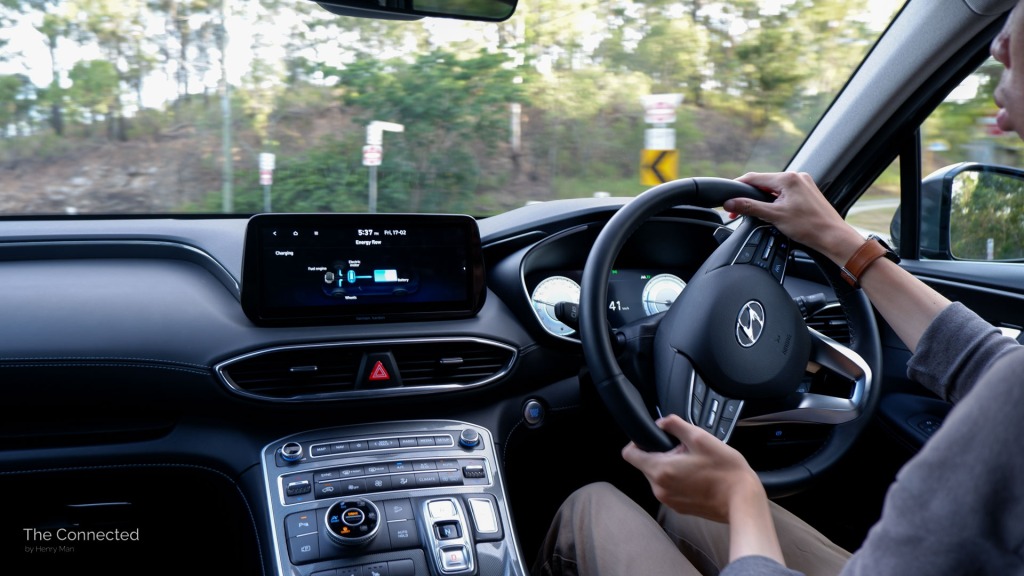
Driving.
2023 Hyundai Santa Fe Hybrid powertrain specs:
| Engine + Electric motor | 1.6-litre turbocharged four-cylinder petrol engine + 44kW permanent magnet electric motor |
| Battery size | 1.49kWh lithium-ion |
| Combined power | 169kW @5500rpm |
| Combined torque | 350Nm @1000-4500rpm |
| Drive Type | All-wheel drive (on-demand) |
| Transmission | Six-speed torque converter automatic |
| 0-100km/h time | N/A |
| Towing (braked / unbraked) | 1650 / 750kg |
The Hyundai Santa Fe Hybrid adopts a 1.6-litre turbo-petrol engine, which seems to be a detuned version of the unit found on the i20N hot hatch and i30 N-Line.
It combines with a small battery and electric motor to form a series-parallel hybrid system – the same setup used by Toyota – and on-demand all-wheel drive.
The series-parallel hybrid system works seamlessly at switching between modes, even though activating the petrol engine does sound a noticeable roar.
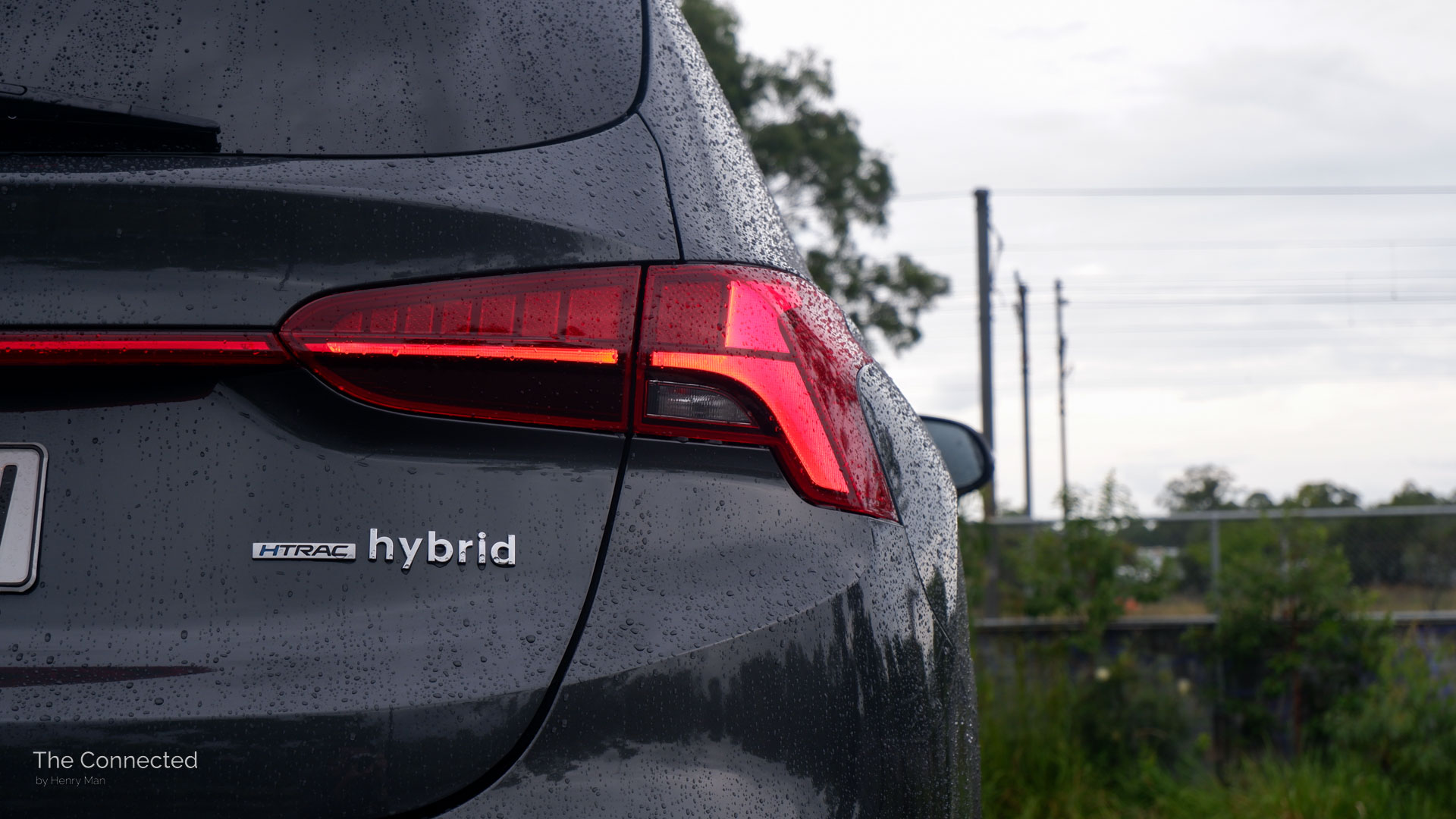
Series-parallel hybrid explained.
Series = electric motor solely drives the vehicle, with the engine and regen braking generating charge.
Parallel = engine and electric motor constantly work together to drive the vehicle.
Therefore, a series-parallel system automatically switches between both modes – EV-only, engine-only or both to maximise efficiency and suit the driving condition.
I was surprised that there were frequent ‘electric-only moments’ (series mode) – it turns off the engine anytime there was enough battery charge when little power is needed (i.e. low car park speeds), regenerative braking (even just a little while slowing down), maintaining a speed up at 90km/h (when there’s no road incline), and idling to keep the air-con running.
The latter does drain the tiny battery quickly, but once it reaches around 25 per cent charge, it turns on the engine to top it up a bit for about a minute before turning off again. It is quite loud, though, as the engine seems to rev higher to recharge the battery.
It switches to driving the wheels via the engine-only once the accelerator is tapped a bit more, and both powerplants kick in for maximum power when there’s a heavier foot on the pedal (parallel mode).


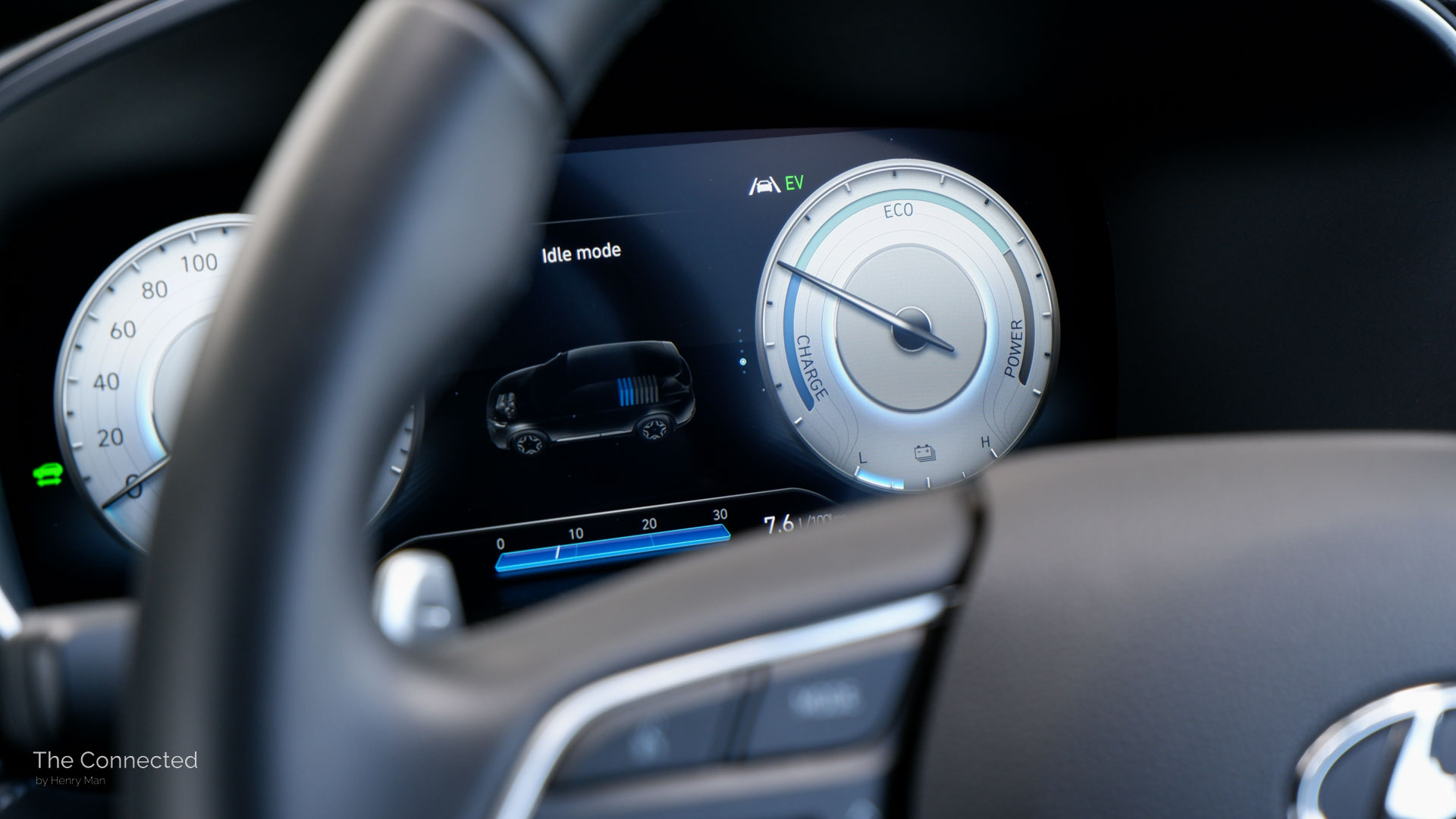
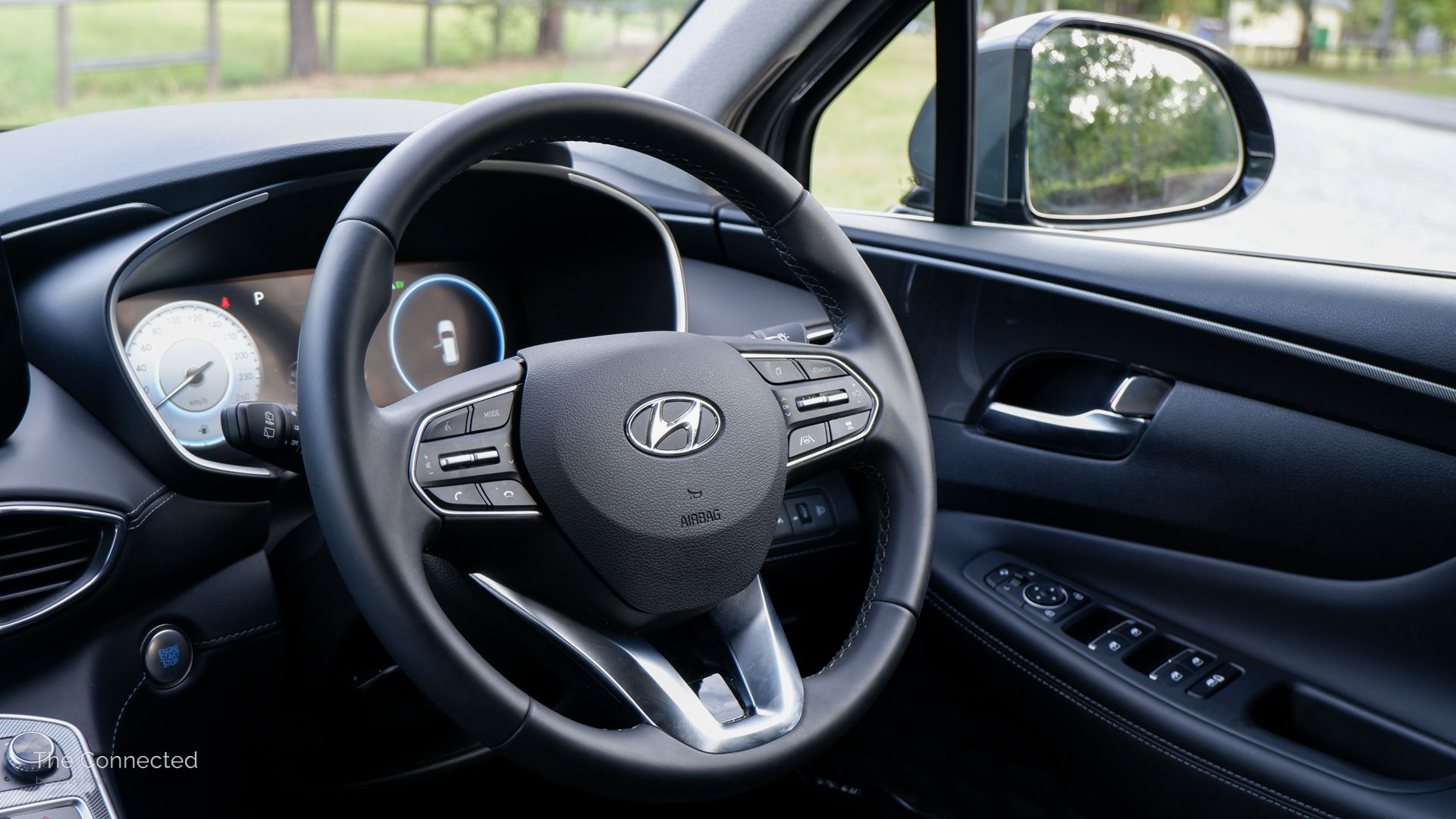
On the other hand, if the battery is fully recharged (eg: after regen braking a lot at hills), then the EV-only mode is disabled completely.
The electric motor gives the Santa Fe Hybrid good torque, although there is a noticeable delay in the torque converter automatic and petrol-electric powertrain responding when acceleration is needed for overtaking, for example.
It defaults to eco mode every time you start the car and the hybrid system encourages a lighter foot on the pedal in order for the engine to not kick in. In contrast, the paddle shifters behind the steering wheel forces the engine to activate and go down a gear for a manual-esque driving experience.
Besides the hybrid system, the large family wagon has good noise isolation and a comfortable ride.
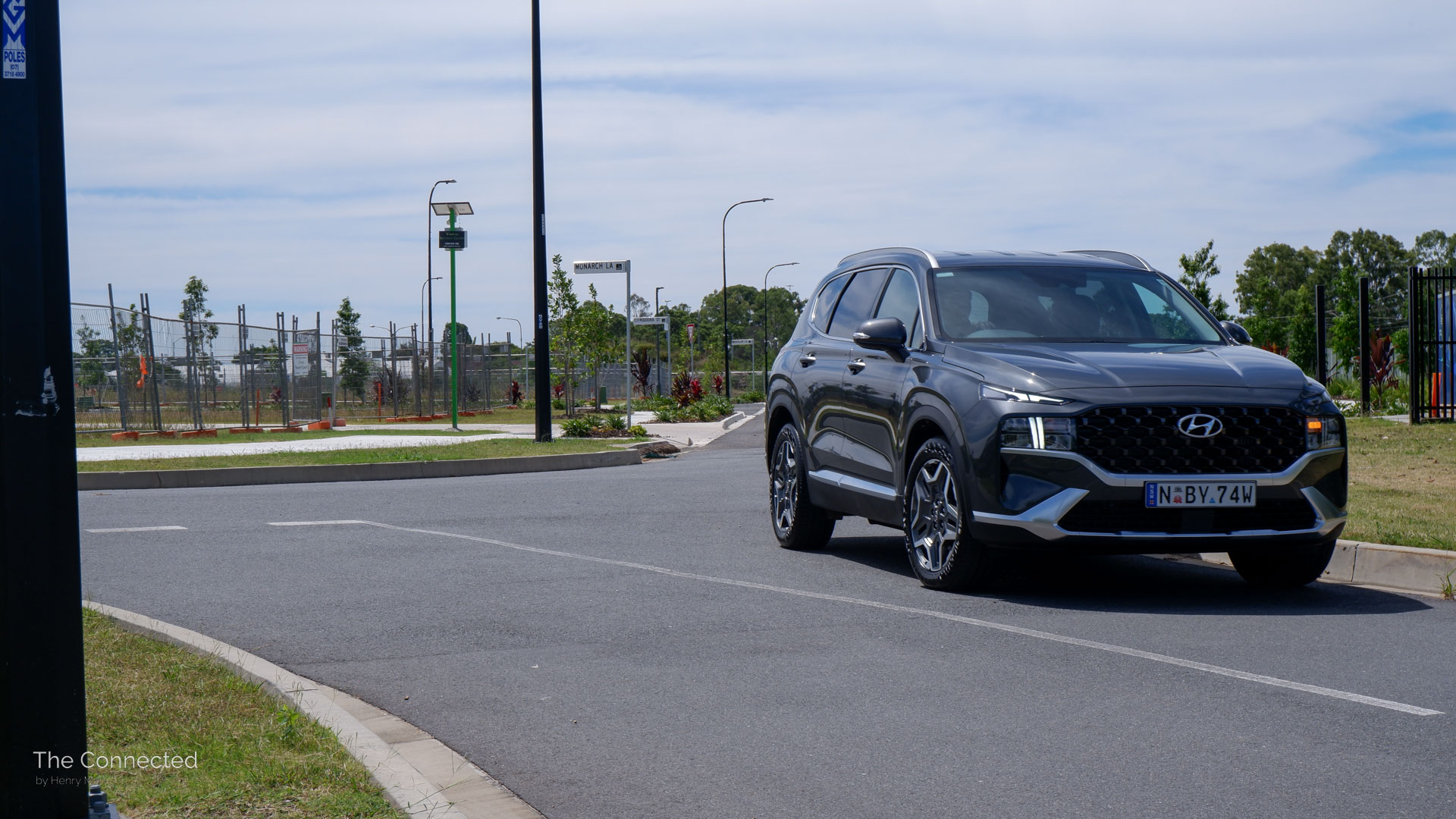
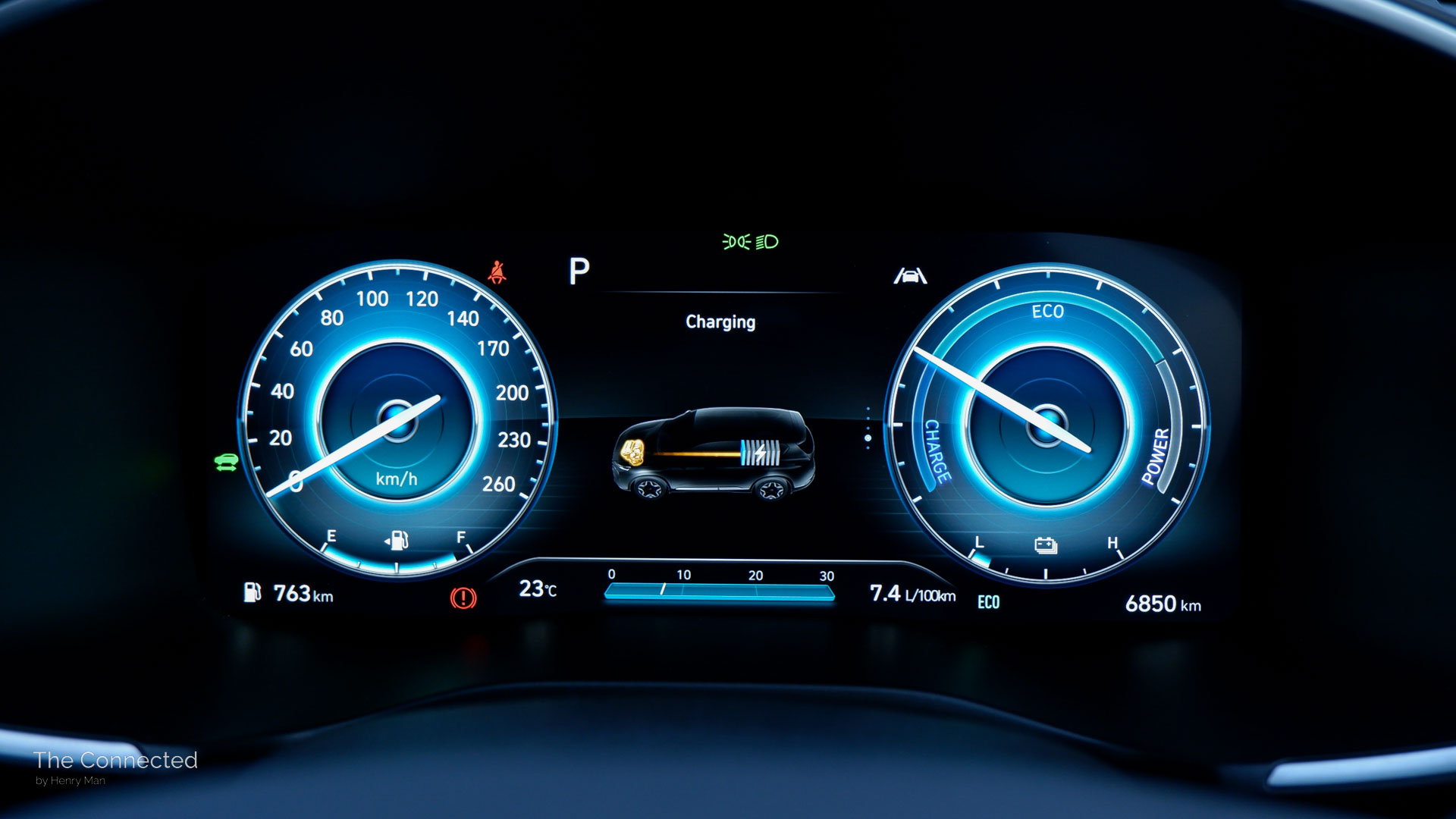
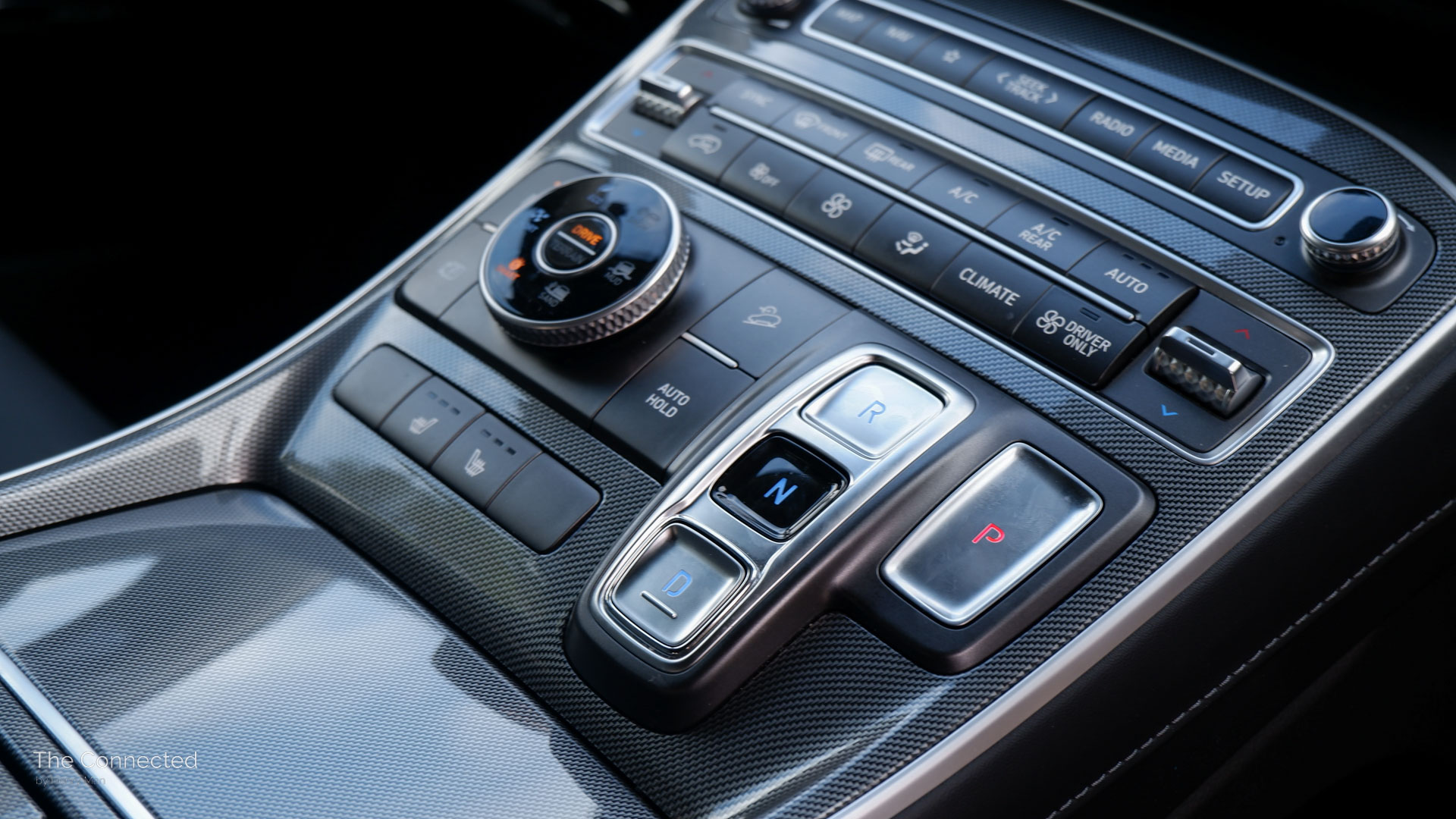
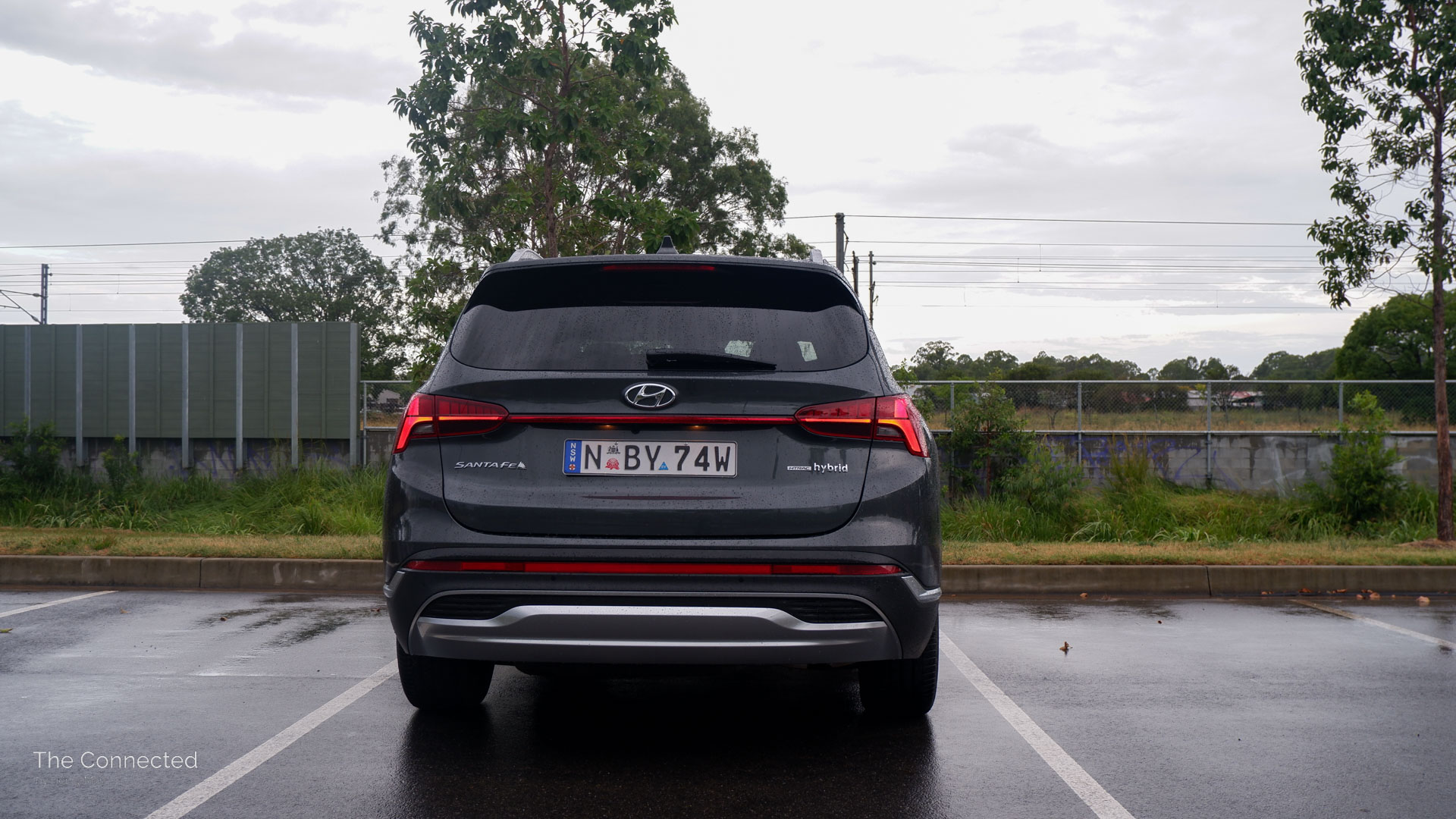
There’s good all-round visibility aided by the A-pillar glass opening thanks the wing mirrors being attached to the body and it’s a good not-too-big size for a three-row SUV to manoeuvre around car parks.
Though, I did find the brake pedal somewhat grabby at low speeds as the weak regen braking system holds on, requiring the driver to lift off the brake pedal completely to encourage the car to move.
The hybrid also can’t tow as much as regular petrol-only and diesel variants, which are rated at up to 2500kg on a braked trailer with a 200kg towball weight (1000kg and 100kg more respectively).
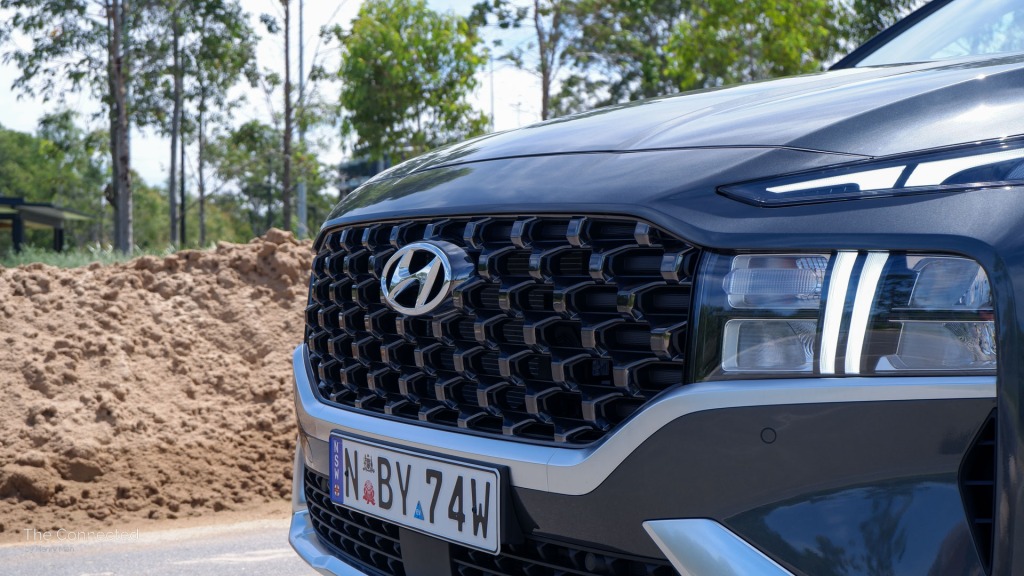
Ownership.
The Hyundai Santa Fe Hybrid is covered by a five-year, unlimited kilometre vehicle warranty and an eight-year/160,000km battery warranty.
Hyundais benefit from a rare unlimited capped-price servicing (meaning all logbook visits are stipulated before going to the dealer) and roadside assistance (renewed 12-months every time you service it with Hyundai).
It requires logbook servicing every 12 months/10,000km. The latter is a bit short, so you’ll need to put it in more frequently if you often drive long distances and take road trips. After the first five visits, it will cost $2295 to maintain.
2023 Hyundai Santa Fe Hybrid capped price servicing prices:
| 12 months/10,000km | 24 months/20,000km | 36 months/30,000km | 48 months/40,000km | 60 months/50,000km |
| $459 | $459 | $459 | $459 | $459 |
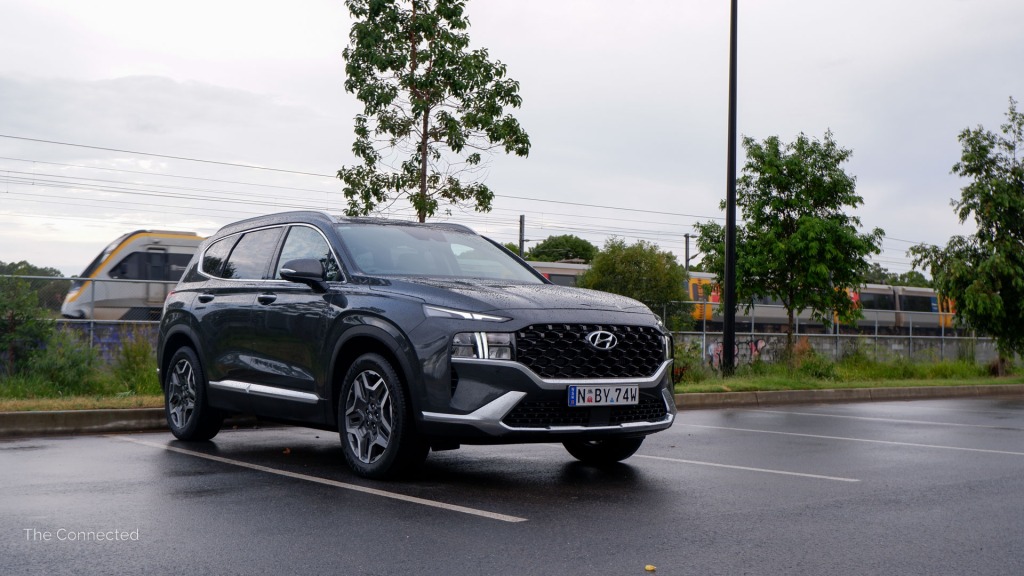
Rivals.
Hyundai’s most direct rival is the larger Toyota Kluger Hybrid (from $57,620 to $79,560 before on-road costs).
It has a claimed 5.6L/100km combined efficiency, which beats the Santa Fe Hybrid’s claim. However, it uses an older, shorter-lasting and environmentally unsustainable nickel-metal hydride (NiMH) battery and requires pricier 95RON premium unleaded fuel.
Meanwhile, the related Kia Sorento Hybrid ($69,750 before on-roads) adopts the same drivetrain system as the Hyundai and is arguably sharper looking, but is only available in one top GT-Line trim and suffers from severely limited supply in Australia.
The Mitsubishi Outlander PHEV Exceed or Exceed Tourer ($67,490 to $69,990 before on-roads) – which are the only variants to offer seven seats – may be another viable alternative if you want more electric-only range when commuting locally and can charge at home.

Would I pick the Hyundai Santa Fe Hybrid?
The Hyundai Santa Fe Hybrid is a solid family SUV choice if you often commute in urban areas and need a seven-seater, but don’t want to drive one that’s too large.
As its marketing suggests, it can be a viable substitute to diesel – as long as you often drive in urban environments to truly reap the long range benefits.
However, with a $6500 price premium compared to the regular petrol-only Santa Fe, it is a tough sell given its real-world fuel economy isn’t as efficient as the claim suggests and can’t tow as much either.
This mid-spec Elite still misses out on a 360-degree camera and reverse AEB – which I’d argue is essential safety assist tech for any large SUV – the lack of a climate control display is annoying, and the Santa Fe’s third-row is designed for occasional use only due to tighter leg room and limited airbag coverage.



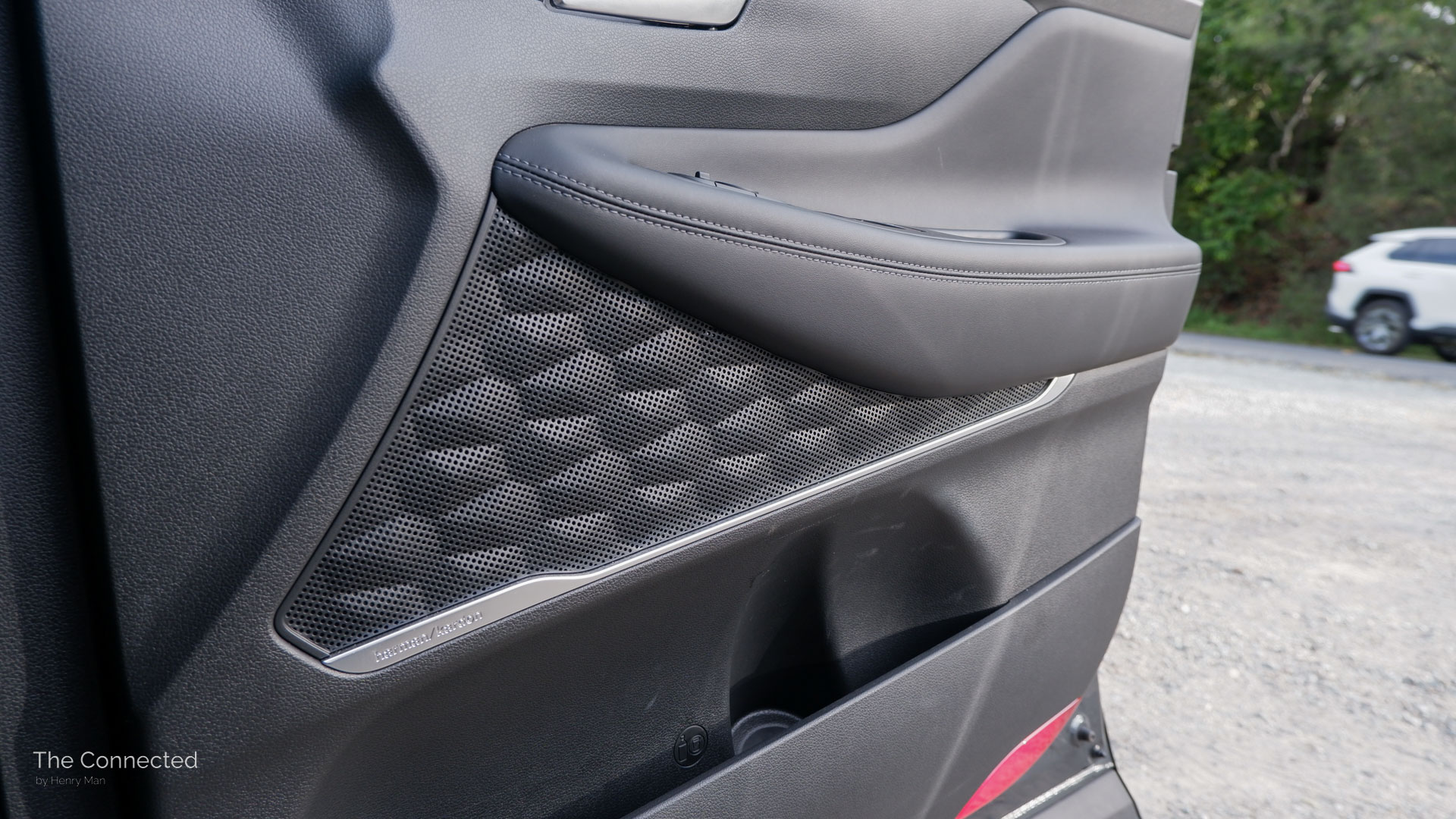

The reality is battery-electric vehicles don’t suit everyone (at least for now). Lower-than-typical driving range and a limited and unreliable public charging infrastructure means pure EVs are only viable if you can charge at home and mostly commute in metro areas or surrounds.
Therefore, traditional hybrids, such as the Santa Fe Hybrid, represents a good stopgap to prevent harmful diesel exhaust fumes with reduced petrol tailpipe emissions, especially in stop-start traffic situations.
It’s worth considering this practical seven-seater SUV if you regularly drive in the city and lower-emissions driving is a high priority (which ought to be).
Photographs by Henry Man
About the Author.
Henry Man is a freelance automotive journalist, communicator and content producer passionate about the intersection of technology and transportation.
He is focused on meaningful journalism, storytelling people, and truth-telling in the public interest. The Connected is an altruistic initiative to publish content free from commercial interests, showcase key work, and highlight how tech and media shapes everyday society. For further information, read more here.
Henry is an alum from The University of Queensland holding a Bachelor of Communication/Journalism (with majors in Public Relations and Digital Media), and has worked with organisations such as Wheels Media, CarExpert, and Zecar.


